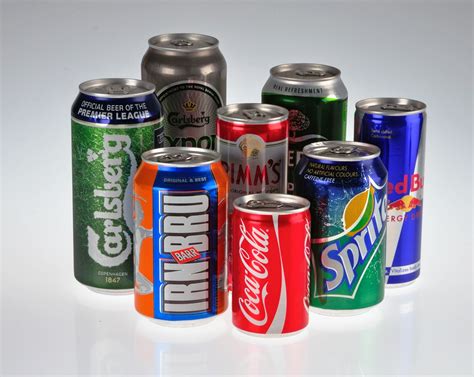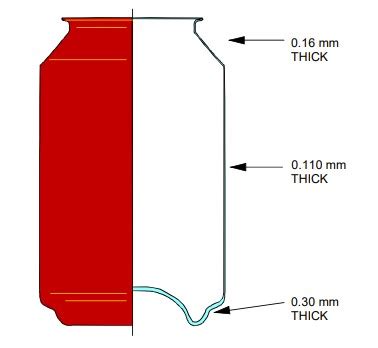aluminum can fabrication process The production process of aluminium cans is divided into 2 main parts: the can body and the can end, each with its separate production process, which are then assembled after the drink has been filled. The Aluminium Coil . www.cadcamfem.com
0 · where are aluminum cans made
1 · thickness of aluminum can
2 · how its made aluminum cans
3 · how are aluminum cans manufactured
4 · average weight of aluminum can
5 · are aluminum cans coated inside
6 · aluminum can material properties
7 · 2 piece can making process
$8.92
1 The modern method for making aluminum beverage cans is called two-piece drawing and wall ironing. The process begins with an aluminum ingot which was cast to be about 30 inches (76 cm) thick, then rolled into a thin sheet.Making a Two-Piece Can. How many pieces are used to make a can? How involved is the process? Get an inside look at how the food and beverage cans we use every day are manufactured.
How Are Aluminum Cans Made? 1. From Ore to Metal: The Smelting Process. The first step in the journey of an aluminum can is smelting. In this process, aluminum oxide is subjected to intense heat within a furnace, .Learn how aluminum cans are made, step-by-step, from forming cups and shaping cans to coating, decorating, and palletizing, ready for shipment. The production process of aluminium cans is divided into 2 main parts: the can body and the can end, each with its separate production process, which are then assembled after the drink has been filled. The Aluminium Coil .
Aluminum can manufacturing plants produce millions of cans per day relying on high-speed equipment, control systems, and technology to monitor performance. All are essential to creating a successful batch of cans. . Making aluminum cans is a complex process that involves mining raw materials, melting and forming aluminum into sheets, adding an adhesive coating, forming the aluminum sheets into cans, applying a protective coating, .
Learn more about how aluminum cans are made, including our cup blanking and drawing, ironing and doming, trimming, and cleaning processes.
The production process of an aluminium can could be broken down into 2 separate production processes which are the production of the can body and the production of the can end, the 2 parts will be later attached after the .The aluminum coils (Alloy 3104 -H19) that arrive at the production plants will be transformed into aluminum beverage cans through a series of equipment and forming processes.1 The modern method for making aluminum beverage cans is called two-piece drawing and wall ironing. The process begins with an aluminum ingot which was cast to be about 30 inches (76 cm) thick, then rolled into a thin sheet.
Making a Two-Piece Can. How many pieces are used to make a can? How involved is the process? Get an inside look at how the food and beverage cans we use every day are manufactured.
How Are Aluminum Cans Made? 1. From Ore to Metal: The Smelting Process. The first step in the journey of an aluminum can is smelting. In this process, aluminum oxide is subjected to intense heat within a furnace, causing it to .Learn how aluminum cans are made, step-by-step, from forming cups and shaping cans to coating, decorating, and palletizing, ready for shipment. The production process of aluminium cans is divided into 2 main parts: the can body and the can end, each with its separate production process, which are then assembled after the drink has been filled. The Aluminium Coil is fed into an Uncoiler machine to unfold the aluminium sheet from the roll. Aluminum can manufacturing plants produce millions of cans per day relying on high-speed equipment, control systems, and technology to monitor performance. All are essential to creating a successful batch of cans. However, the bodymaker and trimmer may be the most essential machines in a can plant.
Making aluminum cans is a complex process that involves mining raw materials, melting and forming aluminum into sheets, adding an adhesive coating, forming the aluminum sheets into cans, applying a protective coating, and printing labels and packaging.
Learn more about how aluminum cans are made, including our cup blanking and drawing, ironing and doming, trimming, and cleaning processes. The production process of an aluminium can could be broken down into 2 separate production processes which are the production of the can body and the production of the can end, the 2 parts will be later attached after the beverage has been filled.The aluminum coils (Alloy 3104 -H19) that arrive at the production plants will be transformed into aluminum beverage cans through a series of equipment and forming processes.
1 The modern method for making aluminum beverage cans is called two-piece drawing and wall ironing. The process begins with an aluminum ingot which was cast to be about 30 inches (76 cm) thick, then rolled into a thin sheet.
Making a Two-Piece Can. How many pieces are used to make a can? How involved is the process? Get an inside look at how the food and beverage cans we use every day are manufactured.
How Are Aluminum Cans Made? 1. From Ore to Metal: The Smelting Process. The first step in the journey of an aluminum can is smelting. In this process, aluminum oxide is subjected to intense heat within a furnace, causing it to .Learn how aluminum cans are made, step-by-step, from forming cups and shaping cans to coating, decorating, and palletizing, ready for shipment. The production process of aluminium cans is divided into 2 main parts: the can body and the can end, each with its separate production process, which are then assembled after the drink has been filled. The Aluminium Coil is fed into an Uncoiler machine to unfold the aluminium sheet from the roll.

Aluminum can manufacturing plants produce millions of cans per day relying on high-speed equipment, control systems, and technology to monitor performance. All are essential to creating a successful batch of cans. However, the bodymaker and trimmer may be the most essential machines in a can plant. Making aluminum cans is a complex process that involves mining raw materials, melting and forming aluminum into sheets, adding an adhesive coating, forming the aluminum sheets into cans, applying a protective coating, and printing labels and packaging.Learn more about how aluminum cans are made, including our cup blanking and drawing, ironing and doming, trimming, and cleaning processes.
The production process of an aluminium can could be broken down into 2 separate production processes which are the production of the can body and the production of the can end, the 2 parts will be later attached after the beverage has been filled.
where are aluminum cans made

what size junction box for 2.5 mm cable
what size is corrugated sheet metal
Buy Magic: The Gathering Cards, Yu-Gi-Oh! Cards, Pokémon Cards, One Piece CCG, Digimon TCG, Flesh and Blood, Lorcana, CCG Supplies, and more.
aluminum can fabrication process|aluminum can material properties